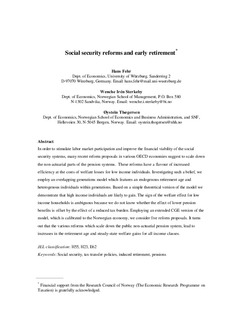Social security reforms and early retirement
Working paper
Permanent lenke
http://hdl.handle.net/11250/162978Utgivelsesdato
2000-09Metadata
Vis full innførselSamlinger
- Discussion papers (SAM) [657]
Sammendrag
In order to stimulate labor market participation and improve the financial viability of the social
security systems, many recent reform proposals in various OECD economies suggest to scale down
the non-actuarial parts of the pension systems. These reforms have a flavour of increased
efficiency at the costs of welfare losses for low income individuals. Investigating such a belief, we
employ an overlapping generations model which features an endogenous retirement age and
heterogenous individuals within generations. Based on a simple theoretical version of the model we
demonstrate that high income individuals are likely to gain. The sign of the welfare effect for low
income households is ambiguous because we do not know whether the effect of lower pension
benefits is offset by the effect of a reduced tax-burden. Employing an extended CGE version of the
model, which is calibrated to the Norwegian economy, we consider five reform proposals. It turns out that the various reforms which scale down the public non-actuarial pension system, lead to
increases in the retirement age and steady-state welfare gains for all income classes.
Utgiver
Norwegian School of Economics and Business Administration. Department of EconomicsSerie
Discussion paper2000:16
